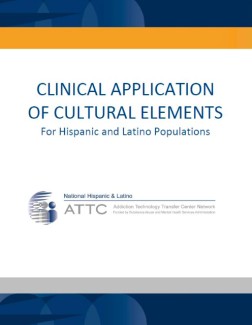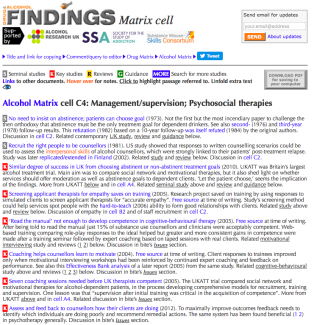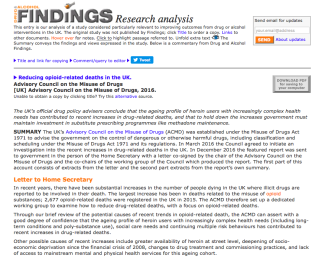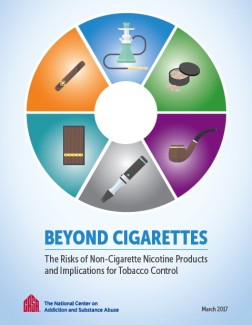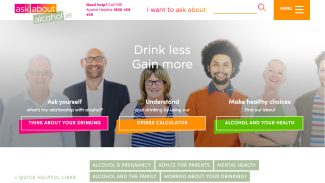Search
Clinical Application of Cultural Elements for Hispanic and Latino Populations
This manual is designed to teach cultural competence concepts, values, and strategies for engagement and treatment with Hispanics and Latinos with substance use disorders (SUD). The manual introduces a basic understanding of cultural...
The Growing Need to Address the Use of New Psychoactive Substances
A recent paper published in the International Journal of Drug Policy addresses the current health responses to new psychoactive substances (NPS), highlighting key issues to inform the planning and implementation of adequate responses in the...
Effectiveness Bank Matrix Bite: Managing the Talking Route to Recovery
Fortnightly instalment of online course on alcohol treatment research starts with a study which concluded that “leaders have a cascading impact on their staff in ways other than through mandate”. Findings that post-training ‘coaching’ is...
Quality of Behavioural Drug Treatment Implementation Dictates its Success
Contingency management (CM) is a widely used behavioural therapy for substance use disorders. It offers material rewards for attending sessions and adhering to prescribed medication courses, amongst other positive behaviours.
A study...
Mental Health and Synthetic Cannabinoid Use
Recently published in the journal Pediatrics, the first prospective study of synthetic cannabinoids (SCs) – chemicals that mimic the effects of marijuana – links depressive symptoms and marijuana and alcohol consumption with an increased...
Highs and Lows: Substance Use and Academic Performance

According to a new study published in the open-access journal PLOS ONE, US college students who consume medium-to-high levels of alcohol and marijuana have a consistently lower grade point average (GPA).
The investigation compared...
A Scientific Development for the Treatment of Cocaine Addiction?
A new study published in the journal Biological Psychiatry claims that one’s desire for cocaine may be reduced by blocking signalling from a specific system in the brain primarily responsible for promoting wakefulness and appetite.
The...
Emotional Abuse during Childhood Linked to Future Opioid Use
Recently published in the journal Addictive Behaviors, a new study claims the existence of a link between childhood abuse and opioid use later in life.
According to the investigation, emotional abuse, specifically, more so than sexual or...
Reducing Opioid-Related Deaths in the UK
Robust messages for the government from the UK’s official drug policy advisers:
- Ageing profile of multiply-ill heroin users will continue to press up drug-related deaths.
- To counteract this pressure government must maintain investment...
Limited Opportunities? Caring for People with Substance Use Disorders
ISSUP at the 60th Session of the Commission on Narcotic Drugs
Evaluating Communities That Care (CTC)
‘Community coalitions’ is a preventative strategy that coordinates activities and resources to reduce adolescent substance use and delinquent behaviour, mobilising communities in the promotion of health and prevention initiatives.
Communit...
Understanding the Brain’s Role in Drug Addiction

Findings recently revealed in Neuroscience & Biobehavioral Reviews and the Journal of Neuroscience suggest the cerebellum is co-responsible for the alterations in the brain that are linked with excessive substance abuse.
This goes...
Sporting Activity and Substance Abuse among Teens: What’s the Link?

A recent survey which looked at the drug habits of over 20,000 US high-school athletes has found those who play high-contact sports, such as hockey, are more likely to use heroin and prescription opioids for non-medicinal purposes.
The...
Preventing and Treating Tobacco Use among Canadian Youth
The Canadian Task Force on Preventive Health Care has issued a new evidence-based guideline for combatting tobacco use by children and young adults aged 5 – 18, suggesting that physicians ought to have a more active role in the prevention...
Good Policy and Practice in Health Education
Booklet 10: Education sector responses to the use of alcohol, tobacco and drugs
The latest volume in the Good Policy and Practice in Health Education Series has been developed via international consultation between the United Nations...
Public Health Strategies to Prevent Neonatal Abstinence Syndrome: CDC Grand Rounds
Public Health Burden of Neonatal Abstinence Syndrome
Neonatal abstinence syndrome (NAS) is a drug withdrawal syndrome that most commonly occurs in infants after in utero exposure to opioids, although other substances have also been...
Beyond Cigarettes: The Risks of Non-Cigarette Nicotine Products and Implications for Tobacco Control
BACKGROUND
Whereas much is known about the effects of tobacco use, the current state of knowledge regarding non-cigarette nicotine products, such as electronic nicotine delivery systems (e-cigarettes and other vaping devices), water pipe...
New Alcohol Awareness Website
The Irish Health Service Executive (HSE) has launched a new alcohol awareness website. ‘Ask About Alcohol’ provides information on health risks associated with drinking alcohol to enable people to manage their own health better. Furthermore...

